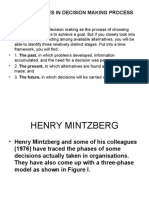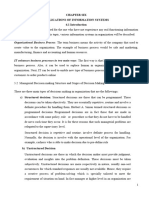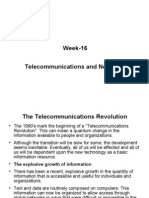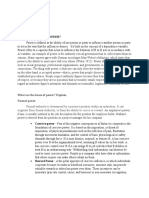0 ratings0% found this document useful (0 votes)
109 viewsWeek 7
This document discusses decision making and information systems at different organizational levels. It covers:
1) Four levels of decision making - strategic, management control, knowledge-level, and operational control - and the types of information systems that support each level.
2) The decision making process involves intelligence, design, choice, implementation, and feedback stages. Information systems help improve this process.
3) Three schools of management theory - technical-rational, behavioral, and cognitive - and how information systems can enhance the characteristics of each approach.
Uploaded by
api-3737023Copyright
© Attribution Non-Commercial (BY-NC)
Available Formats
Download as PPT, PDF, TXT or read online on Scribd
0 ratings0% found this document useful (0 votes)
109 viewsWeek 7
This document discusses decision making and information systems at different organizational levels. It covers:
1) Four levels of decision making - strategic, management control, knowledge-level, and operational control - and the types of information systems that support each level.
2) The decision making process involves intelligence, design, choice, implementation, and feedback stages. Information systems help improve this process.
3) Three schools of management theory - technical-rational, behavioral, and cognitive - and how information systems can enhance the characteristics of each approach.
Uploaded by
api-3737023Copyright
© Attribution Non-Commercial (BY-NC)
Available Formats
Download as PPT, PDF, TXT or read online on Scribd
You are on page 1/ 25
Week-7
Introduction to Decision Making related to
Information Systems
Introduction to Decision Making
• Everybody makes decisions. It's a natural
part of life, and most of the time we don't
even think about the process. In an
organization, decisions are made at every
level. The level at which the decision is
made can also determine the complexity
of the decision in relation to the input of
data and output of information.
Levels of Decision Making
• There are various types of Information
Systems and how they relate to the levels
of an organization.
• We can also relate those Information
Systems to the types of decisions
managers make.
• Strategic Decision Making. These
decisions are usually concerned with the
major objectives of the organization, such
as "Do we need to change the core
business we are in?" They also concern
policies of the organization, such as "Do
we want to support affirmative action?"
• Management Control. These decisions
affect the use of resources, such as "Do
we need to find a different supplier of
packaging materials?" Management-level
decisions also determine the performance
of the operational units, such as "How
much is the bottleneck in Production
affecting the overall profit and loss of the
organization, and what can we do about
it?"
• Knowledge-Level Decision Making.
These decisions determine new ideas or
improvements to current products or
services. A decision made at this level
could be "Do we need to find a new
chocolate recipe that results in a radically
different taste for our candy bar?"
• Operational control. These decisions
determine specific tasks that support
decisions made at the strategic or
managerial levels. An example is "How
many candy bars do we produce today?"
Types of Decision Making
• Structured versus Unstructured
• Some decisions are very structured while others
are very unstructured. You may wake up in the
morning and make the structured, routine
decision to get out of bed. Then you have to
make the unstructured decision of what clothes
to wear that day (for some of us this may be a
very routine decision!). Structured decisions
involve definite procedures and are not
necessarily very complex. The more
unstructured a decision becomes, the more
complex it becomes.
Fig 1: Information systems support different decisions at different organization levels
• One size does not fit all when it comes to
pairing the types of systems to the types
of decisions. Every level of the
organization makes different types of
decisions, so the system used should fit
the organizational level, as shown in
Figure 1
• It's easy to develop an information system to support
structured decision making. Do you increase production
on the day shift or hold it to the swing shift; do you
purchase another piece of equipment or repair the old
one? What hasn't been so easy to develop is a system
that supports the unstructured decision making that
takes place in the upper echelons of a company. Do we
expand into foreign markets or stay within the confines of
our own country; do we build a new plant in Arizona or
Alabama; do we stop production of a long-time product
due to falling demand or boost our marketing? The ability
to create information systems to support the latter
decisions is long overdue.
Stages of Decision Making
• Some people seem to make sudden or
impulsive decisions. Other people seem to
make very slow, deliberate decisions. But
regardless of appearances, the decision-
making process follows the same stages
of development and implementation.
• Let's use the example of purchasing a
new television, using Figure 2.
Fig 2: The decision-making process.
• Intelligence: You identify the facts: You don't
have a television or the one that you do have
isn't any good. You intuitively understand what
the problem is and the effect it's having on you.
You missed your favorite show last night.
• Design: You design possible solutions: You
could watch the television in your neighbor's
apartment or you could purchase a new one for
yourself. Your neighbor will get annoyed if you
keep coming over. On the other hand, you won't
be able to go on vacation if you use your money
to buy a new television.
• Choice: You gather data that helps you make a better
decision: Your neighbor doesn't like the same shows you
like or she's getting rather tired of you being there. You
also determine that televisions cost a lot of money so
you figure out how you can afford one. You choose to
purchase a new television instead of watching your
neighbor's.
• Implementation: You implement the decision: You stop
at the appliance store on your way home from work and
carry out your decision to purchase a new television.
• Feedback: You gather feedback: You're broke but you
can watch anything you want!
• Of course this is a simplified example of the decision-
making process. But the same process is used for
almost every decision made by almost every person.
• Information Systems help improve the decision-making
process by
– providing more information about the problem
– presenting a greater variety of possible alternatives
– showing consequences and effects of choices
– measuring the outcome of different possible solutions
– providing feedback on the decision that is made
• Bottom Line: Different types of decisions require
different types of systems. All decisions follow the
same pattern although some may be more complex
and require several iterations of the decision-making
stages.
What Managers Do
• Managers help keep chaos to a minimum. We've all
worked for the person who proves this theory wrong, but
when all is said and done, minimizing chaos is the
manager's number one job.
• An organization's success is built around its managers,
but also relies on technical competence, adaptability to
its environments, and a thorough knowledge of its
product and production processes. Some companies
seem to "get it," while others companies just seem to get
lost! Why? Management is the answer: management of
the employees, management of the product, and
management of information.
Three Schools of Management
• Let's take a close look at the three schools
of management (technical-rational
perspective, behavioral, and cognitive),
and see how they fit into different
organizations. As we discuss the
management theories you should
concentrate on how they would use
various information system configurations
to enhance their characteristics.
Fig 3: The evolution of management theory.
The Technical-Rational Perspective
• The technical-rational or classical perspective
basically views people as machines. The manager's job
is to keep the machine running smoothly and in concert
with all the other machines. The manager is also
responsible for creating an administration that keeps the
machine well-oiled and fixes any broken parts.
• Henri Fayol's classic theory of management says
managers perform five distinct functions:
• Planning
• Organizing
• Coordinating
• Deciding
• Controlling
Con’t
• In order to fulfill each of these functions, a manager must
communicate. Think about it. If a manager devises a
plan, doesn't she have to tell someone what that plan is?
If the manager coordinates a new plan, doesn't he have
to communicate with someone about the new plan? If
the manager makes a decision, doesn't someone have
to know what that decision is?
• The people a manager communicates with, regardless of
the action, are all around him/her. They could be at a
lower or higher management level. They could be inside
or outside the organization. It doesn't matter.
• The role of information systems, using the technical-
rational perspective, is to improve the mechanical
operation of the organization.
Behavioral Perspective
• We all know that humans aren't machines. They
don't work in isolation from other humans, and
there are many more factors to take into
consideration when managing humans rather
than machines. The behavioral perspective
takes these important characteristics into
account. Just as humans are living, breathing,
ever-changing beings, so too are organizations.
• The manager's role is to assist the organization
in continually changing and adapting to its
environment.
Con’t
• This management theory gives you insight into the use
of information systems to enhance the effectiveness of
the organization. It has had a powerful influence on the
field of information systems:
• User acceptance literature emphasizes the sociological
and psychological aspects of the system success.
• Strategic IS literature emphasizes the importance of
responding to and dominating the environment.
• Network organization and virtual organization literature
emphasizes organizing labor without traditional
hierarchies.
Con’t
• Managerial Roles: Mintzberg
• In his research, Mintzberg found that managerial roles
fell into three categories:
• Interpersonal. Managers act as representatives of the
organization to internal and external audiences.
• Informational. Managers pass information up and down
and around the organization.
• Decisional. Once managers make a decision, they must
pass it on to someone else. But before they can make
that decision, they have to gather information from
internal/external sources.
Con’t
• How Managers Get Things Done: Kotter
• Kotter argues that managers are always looking out for
themselves. They establish agendas and goals, build
interpersonal networks, and then execute their own
personal agendas.
• What Managers Decide: Wrapp
• Wrapp's theory of management describes managers not
as dictators but as guides. They guide the people and
the organization as a whole toward consensus goals.
They understand that no part of the organization can
work in isolation from other parts and that it takes the
whole team to win the game.
You might also like
- The Following Are The Main Types of Decisions Every Organization Need To TakeNo ratings yetThe Following Are The Main Types of Decisions Every Organization Need To Take12 pages
- 5 Simon's Decision Making & Management Information SystemNo ratings yet5 Simon's Decision Making & Management Information System21 pages
- Information Technology and Decision Making: - Intellectual CapitalNo ratings yetInformation Technology and Decision Making: - Intellectual Capital27 pages
- Creating An Ethical Work Environment - Ethical Decision Making - Ethics in Information TechnologyNo ratings yetCreating An Ethical Work Environment - Ethical Decision Making - Ethics in Information Technology42 pages
- Decision Making For Business and Strategic ChoicesNo ratings yetDecision Making For Business and Strategic Choices43 pages
- Unit-1: Chapter 2: Decision Support SystemNo ratings yetUnit-1: Chapter 2: Decision Support System25 pages
- Decision Making Skills - Management Project100% (2)Decision Making Skills - Management Project26 pages
- Types of Decisions Unstructured/ Nonprogrammed Structured/ Programmed Semi-StructuredNo ratings yetTypes of Decisions Unstructured/ Nonprogrammed Structured/ Programmed Semi-Structured10 pages
- Decision Making (DM) : - Every Manager Strives To Do Making Good DecisionsNo ratings yetDecision Making (DM) : - Every Manager Strives To Do Making Good Decisions30 pages
- Lecture - 8 4.3 Individual Models of Decision Making: The Rational ModelNo ratings yetLecture - 8 4.3 Individual Models of Decision Making: The Rational Model6 pages
- Three Phases in Decision Making ProcessNo ratings yetThree Phases in Decision Making Process42 pages
- Decision Making and Information Systems: by Nakato RuthNo ratings yetDecision Making and Information Systems: by Nakato Ruth38 pages
- 4. SIMON'S DECISION MAKING & MANAGEMENT INFORMATION SYSTEMNo ratings yet4. SIMON'S DECISION MAKING & MANAGEMENT INFORMATION SYSTEM44 pages
- Marketing Information System Chapter SixNo ratings yetMarketing Information System Chapter Six15 pages
- Decision Support Systems and Business IntelligenceNo ratings yetDecision Support Systems and Business Intelligence59 pages
- Evidence Guided: Creating High Impact Products in the Face of UncertaintyFrom EverandEvidence Guided: Creating High Impact Products in the Face of UncertaintyNo ratings yet
- Week-9 Ethics and Codes of Professional ConductNo ratings yetWeek-9 Ethics and Codes of Professional Conduct14 pages
- The Historical Evolution of Employee Engagement and Self-Efficacy ConstructsNo ratings yetThe Historical Evolution of Employee Engagement and Self-Efficacy Constructs25 pages
- Chapter 1 Introduction To Management and OrganizationsNo ratings yetChapter 1 Introduction To Management and Organizations6 pages
- Connecting People - The Interpersonal Excellence: Tariq Ali Panjwani Asst. Manager T&ODNo ratings yetConnecting People - The Interpersonal Excellence: Tariq Ali Panjwani Asst. Manager T&OD32 pages
- Tips For Growing A Successful Business: MoneyNo ratings yetTips For Growing A Successful Business: Money2 pages
- Understanding Culture, Society, and Politics: Social DynamicsNo ratings yetUnderstanding Culture, Society, and Politics: Social Dynamics36 pages
- What Is Authority? Power?: What Are The Bases of Power? Explain. Formal PowerNo ratings yetWhat Is Authority? Power?: What Are The Bases of Power? Explain. Formal Power6 pages
- Strategies To Overcome Speaking Anxiety PDF100% (1)Strategies To Overcome Speaking Anxiety PDF22 pages
- Institute of Health Faculty of Health Sceince School of NursingNo ratings yetInstitute of Health Faculty of Health Sceince School of Nursing17 pages
- MG6851-Principles of Management QUESTION BANKNo ratings yetMG6851-Principles of Management QUESTION BANK10 pages
- The Following Are The Main Types of Decisions Every Organization Need To TakeThe Following Are The Main Types of Decisions Every Organization Need To Take
- 5 Simon's Decision Making & Management Information System5 Simon's Decision Making & Management Information System
- Information Technology and Decision Making: - Intellectual CapitalInformation Technology and Decision Making: - Intellectual Capital
- Creating An Ethical Work Environment - Ethical Decision Making - Ethics in Information TechnologyCreating An Ethical Work Environment - Ethical Decision Making - Ethics in Information Technology
- Decision Making For Business and Strategic ChoicesDecision Making For Business and Strategic Choices
- Types of Decisions Unstructured/ Nonprogrammed Structured/ Programmed Semi-StructuredTypes of Decisions Unstructured/ Nonprogrammed Structured/ Programmed Semi-Structured
- Decision Making (DM) : - Every Manager Strives To Do Making Good DecisionsDecision Making (DM) : - Every Manager Strives To Do Making Good Decisions
- Lecture - 8 4.3 Individual Models of Decision Making: The Rational ModelLecture - 8 4.3 Individual Models of Decision Making: The Rational Model
- Decision Making and Information Systems: by Nakato RuthDecision Making and Information Systems: by Nakato Ruth
- 4. SIMON'S DECISION MAKING & MANAGEMENT INFORMATION SYSTEM4. SIMON'S DECISION MAKING & MANAGEMENT INFORMATION SYSTEM
- Decision Support Systems and Business IntelligenceDecision Support Systems and Business Intelligence
- Evidence Guided: Creating High Impact Products in the Face of UncertaintyFrom EverandEvidence Guided: Creating High Impact Products in the Face of Uncertainty
- The Historical Evolution of Employee Engagement and Self-Efficacy ConstructsThe Historical Evolution of Employee Engagement and Self-Efficacy Constructs
- Chapter 1 Introduction To Management and OrganizationsChapter 1 Introduction To Management and Organizations
- Connecting People - The Interpersonal Excellence: Tariq Ali Panjwani Asst. Manager T&ODConnecting People - The Interpersonal Excellence: Tariq Ali Panjwani Asst. Manager T&OD
- Understanding Culture, Society, and Politics: Social DynamicsUnderstanding Culture, Society, and Politics: Social Dynamics
- What Is Authority? Power?: What Are The Bases of Power? Explain. Formal PowerWhat Is Authority? Power?: What Are The Bases of Power? Explain. Formal Power
- Institute of Health Faculty of Health Sceince School of NursingInstitute of Health Faculty of Health Sceince School of Nursing












































































































